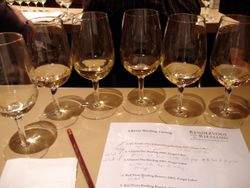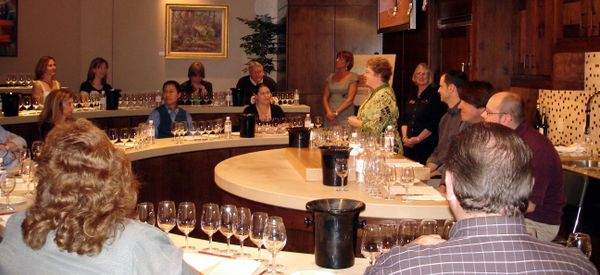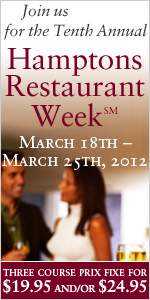By Evan Dawson, Finger Lakes Correspondent
Photos by Jason Feulner, Finger Lakes Correspondent
Something special happened Friday night at the New York Wine Wine & Culinary Center, and the effects are likely to echo for a long time.
Every wine lover has a special bottle or two that stir vivid memories. Simply gazing at the label is enough to transport the owner to the time and place when the bottle was consumed. For me, there is one bottle of wine so special that I can picture the room in which I drank it when I see the label. When I hear the song that was playing at the time (David Grey's "Say Hello Wave Goodbye") I can literally taste the wine once more.
In the Finger Lakes, it has long been a challenge to elevate local wines to this unique place for the wider market. After all, most wines are sold not long after bottling, and most producers urge consumers to drink the wines when they are young. Many special wines can be laid down for a decade or more, and such patience doesn't simply preserve quality, it enhances it.
On Friday night, a trend gained momentum: Finger Lakes rieslings are showing gorgeously as they age, and the consuming public is finally gaining a chance to experience that.
 I was honored to be asked to join a panel presenting Finger Lakes Rieslings at various stages of development. With an audience of about 30 -- an audience that was uniformly geeked out about local wines -- we tasted through eight rieslings. Here was the lineup:
I was honored to be asked to join a panel presenting Finger Lakes Rieslings at various stages of development. With an audience of about 30 -- an audience that was uniformly geeked out about local wines -- we tasted through eight rieslings. Here was the lineup:
- Dr. Frank's Vinifera Wine Cellars 1997 Dry Riesling
- Glenora Wine Cellars 2000 Dry Riesling
- Glenora Wine Cellars 2001 Dry Riesling
- Red Newt Cellars 2002 Dry Riesling
- Red Newt Cellars 2003 Dry Riesling
- Hermann J. Wiemer 2003 Dry Riesling Reserve
- Ravines Wine Cellars 2004 Dry Riesling
- Fox Run Vineyards 2004 Riesling
Anyone who doubts the lifespan of Finger Lakes rieslings ought to have watched the audience taste the 1997 Dr. Frank. It was like inviting a group of people to a book reading and having them read Hemingway for the first time.
Unfortunately, I found the Glenora offerings to be a mess -- slightly off-tasting, oniony and not varietally typical -- though many in the audience enjoyed them as well. But it was the Red Newt 2002 that reached up out of the glass and delivered a knockout blow to me.
As we learned last week with a veritcal of older Wiemer rieslings, 1999 and 2002 Finger Lakes rieslings are showing historically special characteristics. This wine had more layers than a kindergartner waiting for the bus on a winter day in Fargo. Even better, winemaker Dave Whiting says there are at least 10 cases still in existence and some is for sale in the Red Newt Bistro.
Comparing the pair of 2003s and 2004s was a blast, as each wine was made with fruit from different sources and made by winemakers with different techniques. I am deeply intrigued to see where the Ravines style of Dry Riesling goes as it ages, as it marks the driest of Finger Lakes riesling (0.3% RS).
The panel convened by the NYWCC's Shannon Brock, did a fabulous job, and I was simply trying not to get in the way. Wine educator Lorraine Hems is a natural, and Ravines' winemaker Morten Hallgren addressed a variety of thoughtful questions.
As a bonus, Red Newt's Whiting was in the audience to offer insight, as was Fox Run's assistant winemaker Tricia Renshaw, and a longtime member of Dr. Frank's staff.
Nascent wine regions need decades to discover the true arc of aging for their best wines. Thanks to events like this one, we're seeing the Finger Lakes' best rieslings as they evolve into something that is occasionally extraordinary -- perhaps so extraordinary that you'll taste it and freeze the moment in your mind, recalling the music that was playing, the art on the walls, the company with whom you enjoyed the bottle. And perhaps in the future you will hear a song and, somehow, the music will taste like a Finger Lakes Riesling, evolving to tell yet another story when you open it once more.




Do the Finger Lakes wineries have a standard definition of "Dry Riesling"? Noted your impression that you are curious how the driest of these, the Ravines, will age. Were the others comparable? I know that technical dryness does not always translate to the palate (dry Rieslings often fool people by being so fruity that they seem sweet), but curious as to whether this came up. And Was the Fox Run 2004 as low in RS as others, but simply not labeled "dry"?
Posted by: Tish | May 19, 2009 at 09:18 AM
Tish: I'll defer to Evan on that question, but just in my experience with FL rieslings -- no, there isn't a standard definition. One winery may have a "dry" wine that is 1.5% RS but others consider that "off dry".
I guess that's why the International Riesling Foundation has put together their scale, which takes RS, pH and acid together and puts each wine on a scale. Several 2008s that I've seen have adopted it.
Evan: My question is... are any wineries selling these wines in their tasting rooms? I can go to Red Newt when I'm in town next, but I'd love to buy some of these older wines for my cellar.
Posted by: Lenn Thompson | May 19, 2009 at 09:36 AM
Tish,
Ravines was 0.3, most others checked in between 0.7 and 1.2. I asked winemaker Morten Hallgren during the event how he thought a 0.3 Riesing will age, and while I don't want to speak for him, he essentially said that he envisions a long life for the wine. He points to the structure and strong acid backbone, and in his experience his dry Rieslings have slowly brought more exotic fruit notes forward over time. He also pointed out that in such a young region, we're all in a period of discovery, certainly.
Not sure of the Fox Run RS offhand, but I hope Peter Bell or Tricia Renshaw can answer that. It's safe to assume that number is around 2.0. In the Finger Lakes, Dry Riesling runs from 0.3 to about 1.2, but most check in somewhere in the upper middle of that range. Wines labeled "Riesling" or "Semi-Dry Riesling" tend to check in around 2.0 with a little more variability in range.
Posted by: Evan Dawson | May 19, 2009 at 09:36 AM
Lenn,
I don't know the answer, but when it was brought up after the panel, the regular answer I heard was, "Call the winery and we'll talk," or, "We'll see what we can sell." Some of the Red Newt is certainly available; I can't speak with certainty about the rest.
Posted by: Evan Dawson | May 19, 2009 at 09:50 AM
Evan, I enjoyed attending the event and thought that the panel did a tremendous job creating a dialogue with a very curious audience.
My 2 cents: while many of the wines were very good to excellent, the idea of drinking a 12-year-old wine (the Dr. Frank's) and having it shine was most exciting for me. I would have loved an opportunity to taste a batch wines over 10 years old, although what we had was certainly something to work with and all of it will, of course, be over 10 years at some point in the near future. I'm confident many of these wines have some life left in them for many years to come.
Posted by: Jason Feulner | May 19, 2009 at 10:25 AM
Jason,
I understand completely, and of course there is an opportunity coming up to taste 20 years of Rieslings from one winery (that would be Dr. Frank on May 31).
Posted by: Evan Dawson | May 19, 2009 at 11:51 AM
Great post, Evan.
The Fox Run version you tasted was indeed a little over 2% r.s. We find that our dry versions are less apt to develop toast/honey/kerosene flavors with age. They often get a little mean and cranky compared to the bottlings that start off a little sweeter.
I hope everyone has seen this article by now, which came out about 8 years ago:
http://www.rivendellwine.com/article05.html
Posted by: Peter Bell | May 19, 2009 at 05:29 PM
Tasting this great flight of older Rieslings was certainly a treat.
At the risk of sounding like I'm making a shameless plug, I'm posting a link to the menu of a 5 course dinner that Debra is preparing this Friday at Red Newt. The wines will be:
2008 Red Newt "Circle" Riesling
2007 Red Newt Semi Dry Riesling
2006 Red Newt Reserve (dry) Riesling
2006 Tierce Riesling
2005 Tierce Riesling
2004 Tierce Riesling
2003 Red Newt Reserve Dry Riesling
2002 Red Newt Reserve Dry Riesling
Should be fun!
http://rednewt.com/web/index.php?option=com_content&view=article&id=72:may-riesling-wine-table-on-may-22nd-7pm&catid=42:menus&Itemid=107
Thanks!
Posted by: David Whiting | May 19, 2009 at 10:19 PM
Evan,
You are being overly modest when you write "I was simply trying not to get in the way." The discussion you initiated with Morten on seasonal variation and the interaction of climate, location, and winemaking style was for me the high point of the Library Rieslings tasting. To know something about this subject as textbook knowledge is one thing; to listen to a discussion of the topic with the winemakers present, while comparing back-to-back vintages of their wines, was altogether more interesting and informative. My thanks go out to you for getting the discussion started, and to the other members of the panel and the winemakers in the audience for the substantive conversation that followed.
Best,
Neil Miller
Stressingthevine.com
Posted by: Neil Miller | May 20, 2009 at 10:07 AM
Neil,
You're very kind. We all agreed that the level of discussion and debate was higher than we anticipated, largely due to a very strong audience. Just hearing the varied approaches by some undeniably talented winemakers made for fascinating stuff!
Thanks for the comment. Cheers.
Posted by: Evan Dawson | May 20, 2009 at 02:13 PM
good post, but I got to say, NOBODY enjoys hemmingway the FIRST time.
Posted by: Rowland | May 21, 2009 at 11:58 AM
Rowland - A fair point! Aged Riesling is more universally palatable, I suppose.
Posted by: Evan Dawson | May 21, 2009 at 12:10 PM